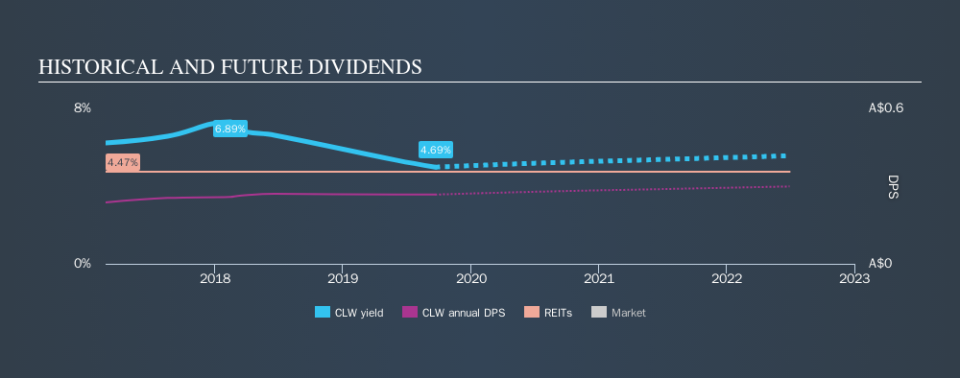Dividend Investors: Don't Be Too Quick To Buy Charter Hall Long WALE REIT (ASX:CLW) For Its Upcoming Dividend

Regular readers will know that we love our dividends at Simply Wall St, which is why it's exciting to see Charter Hall Long WALE REIT (ASX:CLW) is about to trade ex-dividend in the next 4 days. You will need to purchase shares before the 27th of September to receive the dividend, which will be paid on the 14th of November.
Charter Hall Long WALE REIT's next dividend payment will be AU$0.07 per share, on the back of last year when the company paid a total of AU$0.3 to shareholders. Based on the last year's worth of payments, Charter Hall Long WALE REIT has a trailing yield of 4.7% on the current stock price of A$5.73. Dividends are a major contributor to investment returns for long term holders, but only if the dividend continues to be paid. So we need to check whether the dividend payments are covered, and if earnings are growing.
View our latest analysis for Charter Hall Long WALE REIT
Dividends are typically paid out of company income, so if a company pays out more than it earned, its dividend is usually at a higher risk of being cut. Its dividend payout ratio is 92% of profit, which means the company is paying out a majority of its earnings. The relatively limited profit reinvestment could slow the rate of future earnings growth We'd be concerned if earnings began to decline. That said, REITs are often required by law to distribute all of their earnings, and it's not unusual to see a REIT with a payout ratio around 100%. We wouldn't read too much into this. A useful secondary check can be to evaluate whether Charter Hall Long WALE REIT generated enough free cash flow to afford its dividend. It paid out 92% of its free cash flow as dividends, which is within usual limits but will limit the company's ability to lift the dividend if there's no growth.
It's positive to see that Charter Hall Long WALE REIT's dividend is covered by both profits and cash flow, since this is generally a sign that the dividend is sustainable, and a lower payout ratio usually suggests a greater margin of safety before the dividend gets cut.
Click here to see the company's payout ratio, plus analyst estimates of its future dividends.
Have Earnings And Dividends Been Growing?
When earnings decline, dividend companies become much harder to analyse and own safely. If earnings fall far enough, the company could be forced to cut its dividend. With that in mind, we're discomforted by Charter Hall Long WALE REIT's 30% per annum decline in earnings in the past three years. Such a sharp decline casts doubt on the future sustainability of the dividend.
We'd also point out that Charter Hall Long WALE REIT issued a meaningful number of new shares in the past year. It's hard to grow dividends per share when a company keeps creating new shares.
The main way most investors will assess a company's dividend prospects is by checking the historical rate of dividend growth. Charter Hall Long WALE REIT has delivered 4.1% dividend growth per year on average over the past three years. The only way to pay higher dividends when earnings are shrinking is either to pay out a larger percentage of profits, spend cash from the balance sheet, or borrow the money. Charter Hall Long WALE REIT is already paying out 92% of its profits, and with shrinking earnings we think it's unlikely that this dividend will grow quickly in the future.
Final Takeaway
Has Charter Hall Long WALE REIT got what it takes to maintain its dividend payments? While earnings per share are shrinking, it's encouraging to see that at least Charter Hall Long WALE REIT's dividend appears sustainable, with earnings and cashflow payout ratios that are within reasonable bounds. It's not an attractive combination from a dividend perspective, and we're inclined to pass on this one for the time being.
Curious what other investors think of Charter Hall Long WALE REIT? See what analysts are forecasting, with this visualisation of its historical and future estimated earnings and cash flow.
If you're in the market for dividend stocks, we recommend checking our list of top dividend stocks with a greater than 2% yield and an upcoming dividend.
We aim to bring you long-term focused research analysis driven by fundamental data. Note that our analysis may not factor in the latest price-sensitive company announcements or qualitative material.
If you spot an error that warrants correction, please contact the editor at editorial-team@simplywallst.com. This article by Simply Wall St is general in nature. It does not constitute a recommendation to buy or sell any stock, and does not take account of your objectives, or your financial situation. Simply Wall St has no position in the stocks mentioned. Thank you for reading.

